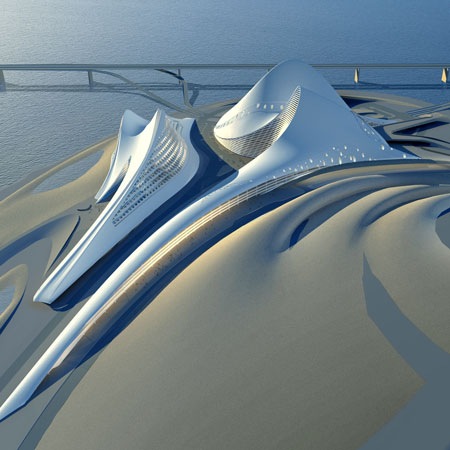Culture in Dubai (an oxymoron?)
 Zaha Hadid's design for a giant opera house in Dubai. The land it was to be built on has reportedly been sold, and will be car park.
Zaha Hadid's design for a giant opera house in Dubai. The land it was to be built on has reportedly been sold, and will be car park.
Foreign Policy reviews a new book (only out in German) by the former head of the Dubai Culture and Arts Authority.
Michael Schindhelm's impressionistic account of Dubai's failed bid to buy an artistic identity by importing talent from around the world joins books in German and English about Dubai as the instantaneous city, with its made-to-order architectural majesty and astonishing new acts of consumerism, on the brink of cracking up even as it was being built. This emerging literature of the collapsed Dubai experiment gives a more detailed picture of the backstage bluster and indecisiveness that led to such unparalleled overreach than one finds in the news coverage. The portrait revealed is depressing, from the fortune-seeking Western consultants jockeying for position to the money-mad al-Maktoum dynasty with its thwarted pretensions to international grandeur.
Meanwhile, in the new issue of Bidoun, Negar Azimi discusses an Iranian artist whose success parallels the rise of Dubai's art market.
There is a manner in which the discomfort Moshiri’s work evokes in some circles mirrors the sensitivities brought on by the peculiar geography that is Dubai — situated just one hundred miles from Iran across the Persian Gulf. Strangely, the artist’s fortunes have closely tracked the dramatic ascendance of that city, a place that inspires wildly diverse reactions, depending on one’s ideas about history, class, and, above all, taste. After all, it is in that glittering Xanadu — where Moshiri is represented by The Third Line Gallery, and spends more and more time — that he came to be known as the auction-house golden boy, the paladin of Christie’s, Sotheby’s, and Bonhams.
In May 2006, Christie’s held its inaugural sale in Dubai, outpacing all expectations and tripling pre-sale estimates. It was not long before Bonhams and Sotheby’s followed suit. By 2007, Christie’s was holding two sales per year at the Emirates Towers Hotel, and in October of that year sold $12.6 million of Arab and Iranian art in one evening alone. Moshiri was featured in these sales and in 2008 broke the auction record for a painting by an Iranian artist, with a work with the Farsi word for LOVE embroidered in Swarovski crystals and gold sequins. There was an irony in the fact that Iranians such as Moshiri could go on living at home, while being within close reach of the flush markets of Dubai. Suddenly, many observers of this young market wondered if the auctions were not distorting the field. And still others called Moshiri a sellout — though often finding it difficult to articulate exactly what he was compromising. As ever, there was the discomfort of seeing someone get fabulously rich from making art. I once asked him if he ever thought of disengaging from the auction market and all its accompanying baggage.
“The refusal to participate wasn’t interesting to me. It wasn’t effective,” he said. “Sure, there were moments, especially when the auction houses would come to Iran to pick up work, that I would be frustrated. But by not entering, what kind of statement are you making? You disappear. Of course, the auction also means that you hope work you made ten years ago, and wish would disappear, will not reappear. But it’s still impossible to withdraw completely, or it was for me.”
On the subject of Dubai, Moshiri is enthusiastic. “To find myself in that position, to witness a modern city being built up, was incredible,” he said. “Things were adventurous, my imagination was running wild. The energy was incredible. To imagine an aesthetic that is completely run out of this world. Nothing was held back. Everything was unchained.”
